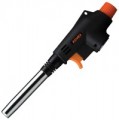Fuel type
The type of fuel for which the device is normally designed.
This parameter is relevant for models using flame heating (in devices operating with an electric arc, fuel is not used as such).
—
Propane-butane. Gaseous fuel in the form of a mixture of pressurized light hydrocarbons, primarily propane (C3H8) and butane/isobutane (C4H10), hence the name. Such a mixture is not only easier to obtain than relatively pure propane or butane — it also has a higher flame temperature (2400 – 2700 °C versus 2100 – 2500 °C).
—
Propane. Gas fuel based on propane. The share of the latter should be at least 75% (depending on the specific brand of fuel). Propane (C3H8) is one of the lighter saturated hydrocarbons; it lends itself well to liquefaction and transportation in cylinders, however, it gives a lower flame temperature than the propane-butane mixture (see the relevant paragraph) — 2100 – 2500 °C versus 2400 – 2700 °C.
—
Bhutan. Gas fuel based on butane (containing at least 60% butane by mass). From the point of view of operational characteristics, butane practically does not differ from the propane described above
—
Acetylene. Gas fuel based on acetylene (C2H2). Acetylene is considered a "classic of the genre" in gas welding and cutting — primarily due to the high flame temperature (3100 – 3600 °C), which all
...ows it to be used for any gas-flame work.
— Methane. Gas fuel based on methane (CH4). Methane is very common and easy to obtain — in particular, it is the main component of natural gas. However, the flame temperature of this fuel is low — 2000 – 2200 °C, which limits its use in welding: only relatively low-melting materials can be cooked with methane. In addition, methane has a rather low calorific value; it is consumed many times faster than the same propane-butane.
— MAF. Gas fuel based on MAF — the so-called. methylacetylene-allene fraction (plus about 25% propane for stabilization). In terms of combustion characteristics, it is similar to acetylene (see the relevant paragraph), it gives a slightly lower flame temperature (from 2900 °C), but has a higher calorific value. At the same time, MAF costs 2-3 times cheaper, compresses better and does not require fillers for storage in cylinders, due to which almost four times more MAF can fit into one standard cylinder than acetylene — 21 kg versus 5.5 kg, with the same total weight containers.
— MAPP. Gas fuel based on MAPP — the so-called. methylacetylene-propadiene fraction. According to the characteristics and features, similar to the MAF described above, it is also used as a substitute for acetylene. Moreover, this type of fuel can be used at higher pressures than acetylene, which is convenient, in particular, for underwater cutting. On the other hand, the MAPP flame contains a higher concentration of hydrogen, which is why it is not suitable for welding large steel parts (although this moment is not critical for small amounts of work).
— Coke oven gas. Fuel based on coke oven gas — a gas obtained by coking coal. Due to its simplicity in production, it is inexpensive, but it gives a relatively low combustion temperature (up to 2300 °C), so that only low-melting materials can be cooked with such fuel. However, this is quite enough for oxygen cutting.
— Universal (gas). This marking means that the burner can work with different types of gas fuel. However, the set of compatible fuel types may be different, it should be specified separately.
— Gasoline. The most popular type of blowtorch fuel; however, it can also be used in cutters (see "Type"). Gasoline evaporates easily, which facilitates its use in such devices, and has the highest combustion temperature among all popular liquid fuels — about 1300 – 1400 °C in atmospheric air. In addition, the advantages of this type of fuel include availability: you can buy gasoline at a hardware store or at a gas station.
— Kerosene. Another popular type of liquid fuel, along with gasoline (see related paragraph). Gives a relatively low flame temperature — up to 800 °C; however, in pure oxygen, this figure can reach 2000 °C. At the same time, we note that very few purely kerosene heaters are produced: since such fuel is very similar to gasoline in physical properties, combined devices that can run on both gasoline and kerosene are more popular.
— Diesel. Liquid fuel, colloquially referred to as diesel fuel. It gives a lower flame temperature than gasoline — about 1100 °C — and evaporates worse, which makes it difficult to use in blowtorches. On the other hand, diesel is more economical: firstly, it generates more thermal energy during combustion, which reduces consumption, and secondly, it costs less than gasoline.Cutting / soldering torch length
Total length of torch or torch (see the relevant paragraph).
Such devices can have different lengths, and each option has its own characteristics. So, short burners and cutters provide better accuracy when working, the movement of such a tool is easier to control; in addition, they are convenient in storage and transportation, because they take up little space. The long length, in turn, provides additional safety: the heating point is at a great distance from the user, thereby reducing the risk that sparks or splashes of molten metal will reach the person. The shortest modern models have a length of about 150 mm, in the longest this size can exceed 1.2 m.
Weight
The total weight of the tool. For models equipped with their own fuel tank, the “dry” weight is indicated, excluding fuel; similarly, the weight of the fuel bottle is not taken into account in devices that look like a bottle cap.

